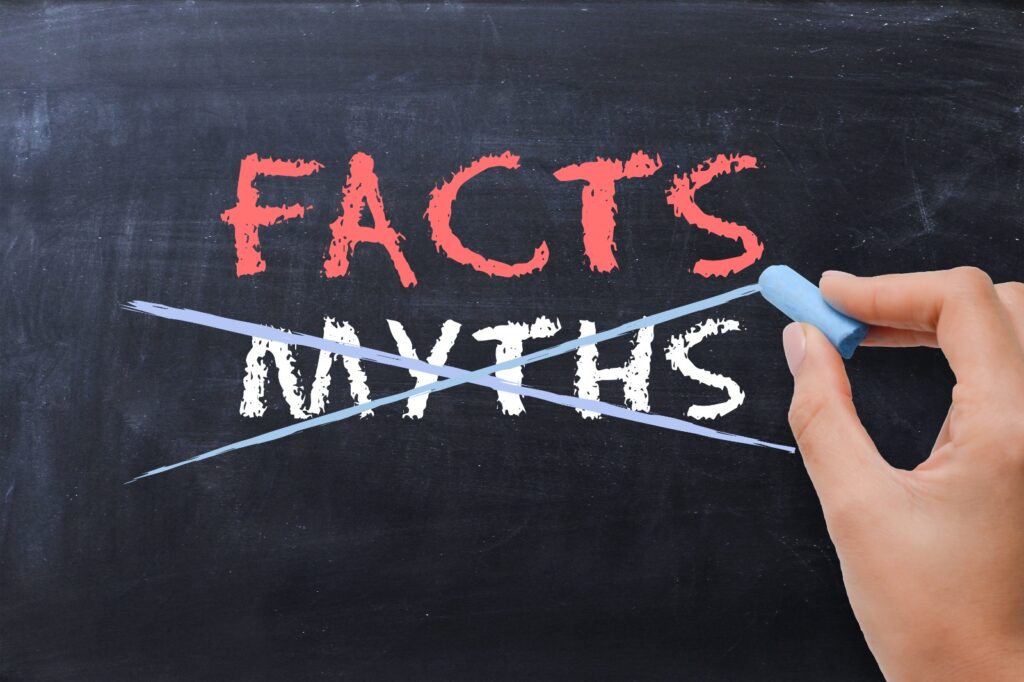Over the years, we’ve straightened countless smiles, fixed thousands of bites, and aligned even the most crooked teeth, all using the innovative Invisalign treatment method.
So it’s fair to say that what we don’t know about Invisalign isn’t worth knowing.
And in that time, we’ve heard all of the tall tales, misconceptions, and downright lies associated with these clear aligners — so much so, in fact, that we thought we’d put our heads together and debunk the Internet’s most common Invisalign myths.
Common Invisalign Myths: Sorting Fact from Fiction
1. You can’t treat complex cases with Invisalign
This may have been true back when Invisalign first arrived on the scene around 20 years ago, but it isn’t the case now. The treatment has been refined, improved and streamlined to the point where Invisalign can treat even the most complex of cases.
2. Invisalign isn’t strong enough to move teeth
Invisalign aligners look simple and discreet, so some people can’t quite grasp the idea that they’re able to exert enough force to move and straighten teeth. But we can assure you that they can move teeth into the desired position — and they do it very effectively. Bit by bit, each set of aligners applies pressure to the right areas to achieve remarkable results.
3. Invisalign can’t move teeth vertically
Okay, so some people will accept that Invisalign can move teeth, but it’s only in a certain direction, right?
Wrong. While in its early stages, Invisalign offered limited movement, today its range of attachments allows us to target complicated alignments, pulling teeth down vertically as well as horizontally. This makes the treatment plan as effective as traditional fixed braces in many cases.
4. Invisalign is more expensive than traditional braces
Like most orthodontic procedures, the cost of Invisalign will come down to the complexity of your case. So you shouldn’t dismiss Invisalign aligners outright based on price alone. In fact, depending on the severity of your misalignment, Invisalign can often work out as cheaper than traditional fixed braces.
Speak with a specialist orthodontist to get the full picture on your treatment options and costs before deciding which is the one for you.
5. Using Invisalign can result in a lisp
There’s an element of truth to this — but it applies to all orthodontic appliances, not just Invisalign.
Anything placed inside your mouth to straighten your teeth has the potential to affect your speech. Some people may develop a slight lisp, while others won’t experience any issues. However, it’s usually something you adapt to quickly.
6. Invisalign takes longer to work
Again, the simple answer to this is: It depends. In some cases, Invisalign may take longer to work, but from our experience, it’s usually the faster of the two treatment options when dealing with minor cases of crowding or misalignment.
The truth is, the type of braces you choose won’t always dictate how long it takes to straighten your teeth. Instead, it will come down to how quickly your teeth move into place, and this can vary from one person to the next.
7. Invisalign stains easily
Invisalign aligners need to be changed every 7 to 14 days to keep pace with your treatment, so, in short, they really shouldn’t have time to stain.
Simply follow the instructions, take them out to eat, drink, and brush your teeth, and clean them thoroughly at least once a day with a soft toothbrush and antibacterial soap. You can even soak them in a warm water solution to keep them extra clear and stain-free.
8. Invisalign is only for teenagers and younger people
You’d be surprised how often we hear this, but it’s simply not true. There’s no upper age limit for Invisalign — or any orthodontic treatment, for that matter.
We understand that traditional braces are most commonly associated with teenagers and younger people, but you can embark on Invisalign treatment long after you’ve hung up your school tie and book bag.
The beauty of Invisalign is that it’s inconspicuous and easy to use. It fits seamlessly into a busy lifestyle, and in this new normal of remote working and video conferencing, they’re a Zoom-ready alternative to traditional treatment methods.
9. Invisalign and online aligners are the exact same
There’s been a recent upsurge in online aligners and DIY teeth straightening treatments. But, as we point out in more depth in our recent post Invisalign vs Online Aligners, there’s a very big difference between the two — both in terms of quality and results.
Without the expert guidance and supervision of a specialist orthodontist, you won’t achieve the same level of precision with DIY aligners as you would with Invisalign.
10. The treatment plan and design of the aligners is all done by a third-party
There’s an assumption shared by some that all we do is take a mould of your teeth and leave the rest up to Invisalign. That is spectacularly wide of the mark.
Your specialist orthodontist is involved in every step of the process, from start to finish. We design your treatment plan and carefully monitor your progress to ensure you avoid risks such as teeth, gum or jaw damage, or root resorption.
11. Any dentist can do Invisalign well
It’s true that many general dentists offer Invisalign to patients dealing with misaligned teeth. But not all dentists are created equal. When it comes to straightening teeth and dealing with malocclusion (i.e., “bad bite”), your best bet is a qualified orthodontist.
We can provide a wide variety of treatments, from traditional metal or ceramic braces to lingual and incognito braces — and, of course, the full range of Invisalign treatments.
If you’d like to learn more about how Invisalign works, speak with one of our specialists. We can even arrange a video consultation during these challenging times, taking you through the treatment in detail, answering your questions, and developing a bespoke plan of action.


